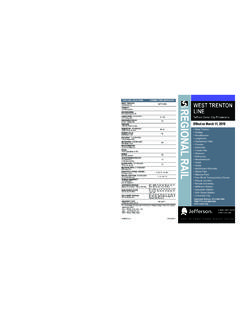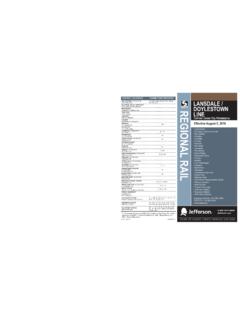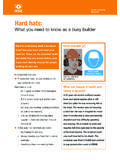Transcription of Body Worn Camera Audit: The First Six Months
1 SEPTA. TRANSIT POLICE DEPARTMENT. February 2017. body worn Camera audit : The First Six Months TABLE OF CONTENTS. Executive Summary .. 1. Transit Police body worn Camera Program .. 2. Video Storage .. 3. Equipment Failures .. 3. Training and Discipline .. 4. Release of BWC Video .. 5. audit and Review .. 5. SECTION ONE .. 6. Procedural Compliance .. 6. SECTION TWO .. 7. Response to Resistance Comparison .. 7. Internal Affairs Comparison .. 8. SECTION THREE .. 9. Officer Perception Survey .. 9. Conclusion .. 10. -i- Executive Summary The introduction of body Camera technology to the arena of policing has been met with mixed reactions from the public and the police. Many are eager to embrace this tool and count on it to be the guardianship needed to ensure professional behavior on the part of the police. Others believe that it will shine the light on the complex realities faced by police officers on a daily basis. The hope is that abuse of authority will decrease, the need for physical force by the police will diminish, and false allegations lodged by citizens against the police will be refuted.
2 This audit reviews the First six Months of body Camera operation for the Southeastern Pennsylvania Transportation Authority's Transit Police Department. The audit provides a public report summarizing the logistical issues related to the program, shares outcomes resulting from BWC use, includes survey results of personnel using BWC, and allows public scrutiny of the BWC program. Highlights of the review included: terabytes of images were recorded 13,970 videos were retained for evidentiary, investigative or training reasons 27 DVRs and 49 cameras were returned to the manufacturer because of malfunctions 40 counseling sessions were held with personnel requiring re-training on the department's policy regarding BWC. 3 members received formal discipline as a result of BWC video Release of video included 19 to the Philadelphia District Attorney's Office; 11 to the Defender Association of Philadelphia or private defense counsel; 127 included as discovery for criminal cases; 20 videos for BWC presentations to the public; and 3 videos to the media 22% of randomly selected incidents failed to have the required corresponding video 21% of randomly selected videos failed to have the required announcement by the officer that audio recording was occurring 5% of randomly selected videos failed to have audio recording 8% of randomly selected videos had the placement of the Camera in a position that interfered with clear video and audio recording Response to Resistance incidents decreased by 19%.
3 Offender injuries decreased by 20%. Officer injuries decreased by 30%. Complaints against members decreased by 25%. -1- Transit Police body worn Camera Program The Transit Police strongly embrace the opportunity to enhance the extensive video surveillance within the SEPTA system by adding the BWC component. A major benefit of the BWC is the audio capability which stakeholders can use to assess the manner by which officers speak to the public. The bulk of complaints filed by citizens often focus on what is said between the police and the person being investigated. Having audio recordings would encourage appropriate behavior on the part of both the police and the public. In July 2013, the Transit Police began researching the viability of using body worn cameras in the mass transit environment. Information was gathered regarding the various types of Camera systems; the administrative processes necessary to manage a BWC program; the options for storing images; existing police department policies; criticisms and concerns of the public and police oversight entities; and methods used to gain support of police officers for BWC.
4 Technology. By July 2014, the Transit Police had received several offers from companies willing to test their products in the subways of Philadelphia. A combination of volunteers and draftees were chosen for the equipment testing stage. The pilot program extended from July 2014 to April 2015. A proposal was submitted to SEPTA's General Manager which described a purchasing plan that would span four years to fully equip the department with body worn Cameras. The General Manager and the Board of Directors authorized the immediate purchase of 300 cameras and the necessary equipment and software to equip the entire department. In May 2015, the procurement process was initiated. The total cost for the BWC program to be implemented was in excess of $400,000. A variety of existing BWC policies and guidelines were gathered and Directive 620 (included as an Appendix) was crafted with the help of police officers, defense attorneys, activists, police oversight experts, the American Civil Liberties Union, and members of the public.
5 In January 2016, training occurred for all sworn personnel and cameras were issued. On 1. January 2016, the BWC program officially began and officers were expected to activate their cameras whenever contact occurred with the public as described in Directive 620. All of the approximately 250 members of the Transit Police from Chief to beat officer are expected to wear their issued body Camera and activate it to capture interactions between the police and the public. -2- Video Storage Video storage represents the prime technological challenge and accounts for the majority of cost for law enforcement agencies implementing a body worn Camera program. The Transit Police Department stores a vast amount of video images as a result of its BWC Program. By policy, the Transit Police Department stores all video taken for 90 days from the time of the recording. Videos containing evidentiary, investigative or training material are flagged and stored beyond the 90-day cycle until ordered purged by the Chief of Police.
6 The average amount of video stored daily is 50,232 megabytes The average amount of video stored in a 90-day cycle is terabytes The First six Months of the BWC program resulted in the storage of terabytes of video The First six Months of the BWC program resulted in the storage of 50,022 videos The First six Months of the BWC program resulted in the retention of 13,970 videos categorized as evidentiary, investigative or training material Equipment Failures Equipment malfunction is a reality when implementing any new technological program. The Transit Police Department requires officers who experience a BWC equipment malfunction to immediately notify a police supervisor and retrieve a working BWC from the available stock as soon as reasonably achievable. Transit Police have tracked the body worn Camera equipment malfunctions and remains in close coordination with the manufacturer for replacement. Since implementation the following equipment failures have occurred: 10 batteries were deemed as faulty and returned for replacement 27 DVRs were deemed as faulty and returned for replacement 49 Camera heads were deemed as faulty and returned for replacement One officer accidentally dropped a BWC unit into a toilet.
7 Six officers have been issued four or more replacement cameras due to malfunctions during the six month period. There is no significant correlation between officers who have a high number of complaints and reports of Camera malfunctions. -3- Training and Discipline The initial training provided to every member of the Transit Police included a thorough review of the BWC policy, a hands-on session for Camera operation, and an explanation of the video uploading process. The Transit Police requires all personnel to formally acknowledge an understanding of the policy. Transit Police Department reinforces the BWC requirements from time to time through the use of quips broadcast over police radio. These quips are short broadcasts designed to emphasize a particular subject; in this case, the reminder to turn on the officer's BWC when responding to calls for service. Through the six-month audit period Transit Police Radio broadcasted BWC. quips on fifteen (15) days.
8 An example of a BWC radio quip is included below: Attention All Personnel: The body worn Camera is a tool that will increase accountability, deter misconduct and protect the civil liberties of the public. Personnel are reminded to inspect and test their BWC before going into service. The BWC should be activated when responding to a call for service and at the initiation of contact by the public. The release of body worn Camera footage will increase transparency and build public trust. Always conduct yourself with the highest degree of professionalism. SEPTA expected that the introduction of this technology would require a learning curve during which Transit Police had to become accustomed to activating their cameras upon seeing misconduct or suspicious behavior. During the adjustment period, supervisors arriving at incidents were required to check the officers' cameras to ensure that they were recording. They had to include in their major incident summaries whether officers had activated their cameras and, if so, at what point during the incident.
9 Shortcomings resulted in counseling sessions which were documented and forwarded to the Captain of Quality Control. Holding the First line supervisors responsible for verifying Camera activation reflected the belief that doing so would expedite the learning process for the officers. In the Transit Police, counseling sessions are training and not a form of discipline. During the First six Months of the BWC implementation, 40 Transit Police participated in counseling sessions reviewing Directive 620. Three members received formal discipline as a result of BWC video. Personnel have been instructed that the failure to activate the BWC during a contact diminishes the officer's credibility and tips the scale for the benefit of the doubt to the citizen who made the complaint alleging misconduct or a lack of professionalism. -4- Release of BWC Video The Pennsylvania Right To Know Act and the Transit Police Department body worn Camera policy provides parameters for the release of body worn Camera video.
10 Five members of the Transit Police have access to the stored video. Any entry into the system is electronically tracked and video review is limited to investigative purposes authorized by a Captain or above. During the First six Months of the BWC program, there were 19 videos released to the Philadelphia District Attorney's Office; 11 videos to the Defender Association of Philadelphia or private defense counsel; 127 videos forwarded as a part of discovery in criminal cases; and 3. videos to the media. audit and Review The Transit Police introduced the BWC program to assist in building trust in policing; protecting the public's civil liberties; ensuring professional behavior; and providing a neutral and objective viewpoint for officer misconduct investigations. To accomplish some of those goals, SEPTA. explored the concept of a neutral audit . The Transit Police asked a private security contractor to provide a quote to conduct weekly reviews of randomly selected videos that would establish a statistically significant sample.














